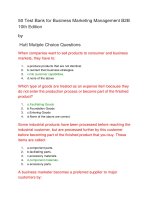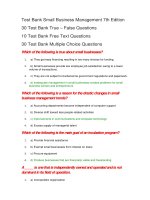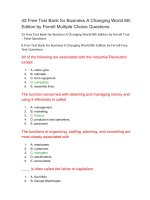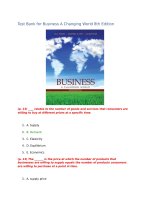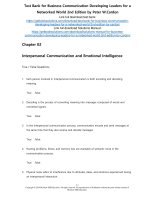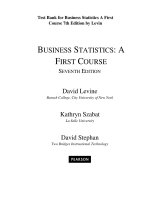Test bank international business; a managerial perspective 8e ch1
Bạn đang xem bản rút gọn của tài liệu. Xem và tải ngay bản đầy đủ của tài liệu tại đây (97.4 KB, 29 trang )
International Business, 8e (Griffin/Pustay)
Chapter 1 An Overview of International Business
1) Which of the following could be considered a major reason that a city would want to host the
Olympic Games?
A) to prevent the economic growth of competing nations
B) the long-term benefits of tourism
C) to test the capacity of national infrastructure
D) to promote international harmony
Answer: B
Diff: 2
Skill: Concept
Objective: 3
2) Which of the following would be considered an international business transaction?
A) purchasing products in one country and assembling them in the same country
B) recruiting employees internationally
C) borrowing money from a major bank to finance capital improvements
D) shipping finished products from one country to another for retail sale
Answer: D
Diff: 2
Skill: Concept
Objective: 1
Learning Outcome: Define the fundamental concepts of international business
3) The Internet has helped small businesses compete in global markets because it ________.
A) allows them to establish a physical presence in each country
B) avoids transactions involving foreign exchange
C) eliminates price controls
D) reduces entry costs
Answer: D
Diff: 2
AACSB: Information Technology
Skill: Concept
Objective: 2
Learning Outcome: Define the fundamental concepts of international business
4) According to the CAGE Model, which of the following refers to the physical,
communications, and transportation links between countries?
A) cultural distance
B) administrative distance
C) geographic distance
D) economic distance
Answer: C
Diff: 2
Skill: Concept
Objective: 2
1
Copyright © 2015 Pearson Education, Inc.
5) Individuals should most likely study international business to ________.
A) comply with graduate school certification requirements
B) ensure that an employer has a global online presence
C) remain current on the latest business methods
D) obtain bilingual business experience
Answer: C
Diff: 2
Skill: Concept
Objective: 2
6) Which of the following has most likely triggered the increase of small businesses involved in
international business?
A) e-commerce
B) economic recession
C) foreign-made materials
D) increased cultural literacy
Answer: A
Diff: 2
AACSB: Information Technology
Skill: Concept
Objective: 2
Learning Outcome: Discuss trends in and the debate over globalization
7) Just-in-time systems were created in ________.
A) the United States
B) Japan
C) Germany
D) China
Answer: B
Diff: 1
Skill: Concept
Objective: 2
8) Just-in-time systems are used by firms to ________.
A) store important data
B) manage inventory
C) monitor production
D) screen job applicants
Answer: B
Diff: 2
Skill: Concept
Objective: 2
2
Copyright © 2015 Pearson Education, Inc.
9) Sony's suppliers deliver necessary inputs as they are needed by Sony. Sony is most likely
using a(n) ________ system.
A) cross-functional
B) just-in-time
C) inventory management
D) on-demand delivery
Answer: B
Diff: 1
Skill: Application
Objective: 2
10) Black and Decker produces tools at a plant in North Carolina and ships the tools to retailers
in England. This is an example of which type of international business activity?
A) merchandising
B) importing
C) exporting
D) trading
Answer: C
Diff: 2
Skill: Application
Objective: 3
Learning Outcome: Discuss the roles of exporting, importing, and countertrade in international
business
11) ________ is the buying of products made in other countries for use or resale in one's own
country.
A) Exporting
B) Importing
C) Merchandising
D) Transporting
Answer: B
Diff: 1
Skill: Concept
Objective: 3
Learning Outcome: Discuss the roles of exporting, importing, and countertrade in international
business
3
Copyright © 2015 Pearson Education, Inc.
12) Sam's Club purchases kalamata olives from Greece for sale in its stores. Which international
business activity does this represent?
A) exporting
B) importing
C) merchandising
D) franchising
Answer: B
Diff: 2
Skill: Application
Objective: 3
Learning Outcome: Discuss the roles of exporting, importing, and countertrade in international
business
13) The British term for the trading of tangible goods is ________.
A) visible trade
B) invisible trade
C) merchandising
D) service franchising
Answer: A
Diff: 1
Skill: Concept
Objective: 3
Learning Outcome: Discuss the roles of exporting, importing, and countertrade in international
business
14) The British term for the trading of intangible goods is ________.
A) visible trade
B) invisible trade
C) merchandise exports and imports
D) service exports and imports
Answer: B
Diff: 1
Skill: Concept
Objective: 3
Learning Outcome: Discuss the roles of exporting, importing, and countertrade in international
business
4
Copyright © 2015 Pearson Education, Inc.
15) Boeing, an American firm, sells commercial aircraft to Lufthansa in Germany. This is an
example of ________.
A) exporting
B) importing
C) licensing
D) franchising
Answer: A
Diff: 2
Skill: Application
Objective: 3
Learning Outcome: Discuss the roles of exporting, importing, and countertrade in international
business
16) Exports account for about ________ of Netherland's gross domestic product?
A) 20%
B) 35%
C) 50%
D) 75 %
Answer: D
Diff: 2
Skill: Concept
Objective: 3
Learning Outcome: Discuss the roles of exporting, importing, and countertrade in international
business
17) The international business activity called ________ occurs when capital is supplied by
residents of one country to residents of another country.
A) international investment
B) global direct investment
C) portfolio financing
D) state capitalism
Answer: A
Diff: 2
Skill: Concept
Objective: 3
Learning Outcome: Define the fundamental concepts of international business
18) ________ are investments made for the purpose of actively controlling property, assets, or
companies located in host countries.
A) Licensing investments
B) Portfolio investments
C) Foreign direct investments
D) Indirect global investments
Answer: C
Diff: 1
Skill: Concept
Objective: 3
5
Copyright © 2015 Pearson Education, Inc.
Learning Outcome: Define the fundamental concepts of international business
19) Which term refers to the location of a parent company's headquarters?
A) host country
B) home country
C) third country
D) local country
Answer: B
Diff: 1
Skill: Concept
Objective: 3
Learning Outcome: Define the fundamental concepts of international business
20) If a company is headquartered in Taiwan, then Taiwan is the company's ________.
A) host country
B) home country
C) dominant country
D) competitive country
Answer: B
Diff: 1
Skill: Application
Objective: 3
Learning Outcome: Define the fundamental concepts of international business
21) Ford Motor Company is based in Detroit, Michigan. It also has offices in Germany, England,
and China. Which of the following is Ford's home country?
A) Germany
B) England
C) China
D) United States
Answer: D
Diff: 2
Skill: Application
Objective: 3
Learning Outcome: Define the fundamental concepts of international business
22) The ________ is where a company operates but is not headquartered.
A) host country
B) home country
C) parental country
D) third party country
Answer: A
Diff: 1
Skill: Concept
Objective: 3
Learning Outcome: Define the fundamental concepts of international business
6
Copyright © 2015 Pearson Education, Inc.
23) Siemens is headquartered in Germany but maintains operations in the United States. The
United States is the ________ country.
A) home
B) host
C) parent
D) subsidiary
Answer: B
Diff: 2
Skill: Application
Objective: 3
Learning Outcome: Define the fundamental concepts of international business
24) Trade between nations can be traced back as far as ________.
A) 2000 BC
B) 500 BC
C) 1200
D) 1600
Answer: A
Diff: 2
Skill: Concept
Objective: 1
25) Which country was a significant focal point for international business during the Middle
Ages?
A) China
B) England
C) Italy
D) Russia
Answer: C
Diff: 2
Skill: Concept
Objective: 1
26) ________ are purchases of foreign financial assets for a purpose other than control.
A) Foreign direct investments
B) Global business investments
C) Foreign portfolio investments
D) Indirect investments
Answer: C
Diff: 1
Skill: Concept
Objective: 3
Learning Outcome: Define the fundamental concepts of international business
7
Copyright © 2015 Pearson Education, Inc.
27) If a Dutch pension fund purchases 1,000 shares of Sony's stock, the Dutch company has most
likely ________.
A) made a foreign direct investment
B) made a foreign portfolio investment
C) earned a higher return on assets
D) earned a lower rate of return
Answer: B
Diff: 2
Skill: Application
Objective: 3
Learning Outcome: Define the fundamental concepts of international business
28) Compared to Thailand, the United Kingdom has a ________ level of exports of goods and
services as a percentage of GDP.
A) slightly lower
B) slightly higher
C) significantly lower
D) significantly higher
Answer: C
Diff: 3
Skill: Concept
Objective: 3
29) Kraft purchased all of the common stock of Cadbury PLC. This is an example of ________.
A) foreign portfolio investment
B) foreign direct investment
C) international expansion
D) global licensing
Answer: B
Diff: 2
Skill: Application
Objective: 3
Learning Outcome: Define the fundamental concepts of international business
30) McDonald's has licensed its brand name, operational systems, and trademarks to individual
restaurant owners in Europe. This is called international ________.
A) leasing
B) marketing
C) franchising
D) diversifying
Answer: C
Diff: 2
Skill: Application
Objective: 3
Learning Outcome: Define the fundamental concepts of international business
8
Copyright © 2015 Pearson Education, Inc.
31) ________ is a contractual arrangement in which a firm in one country allows the use of its
intellectual property by a firm in a second country in return for a royalty payment.
A) Leasing
B) Franchising
C) Licensing
D) Merchandising
Answer: C
Diff: 1
Skill: Concept
Objective: 3
Learning Outcome: Define the fundamental concepts of international business
32) Licensing usually involves permission to use which of the following?
A) real estate
B) trademarks
C) labor leasing
D) production facilities
Answer: B
Diff: 2
Skill: Concept
Objective: 3
Learning Outcome: Define the fundamental concepts of international business
33) Walt Disney permits a German clothing manufacturer to market children's pajamas
embroidered with Mickey Mouse in return for a percentage of company sales. This is an example
of ________.
A) franchising
B) licensing
C) leasing
D) piracy
Answer: B
Diff: 2
Skill: Application
Objective: 3
Learning Outcome: Define the fundamental concepts of international business
34) A(n) ________ involves a firm in one country agreeing to operate facilities for a firm in
another country for an agreed fee.
A) franchising agreement
B) licensing agreement
C) management contract
D) indirect investment
Answer: C
Diff: 2
Skill: Concept
Objective: 3
Learning Outcome: Define the fundamental concepts of international business
9
Copyright © 2015 Pearson Education, Inc.
35) Any organization that engages in cross-border commercial transactions with individuals,
private firms, and/or public sector organizations is a(n) ________.
A) multinational corporation
B) multinational enterprise
C) international business
D) international franchise
Answer: C
Diff: 1
Skill: Concept
Objective: 3
Learning Outcome: Define the fundamental concepts of international business
36) The term ________ is used to identify firms that have extensive involvement in international
business.
A) global operation
B) multinational corporation
C) international conglomerate
D) multidomestic organization
Answer: B
Diff: 1
Skill: Concept
Objective: 3
Learning Outcome: Define the fundamental concepts of international business
37) The International Red Cross is an example of a(n) ________.
A) international business
B) multinational enterprise
C) multinational organization
D) multinational corporation
Answer: C
Diff: 1
Skill: Concept
Objective: 3
38) Which of the following is a common activity of MNCs?
A) training of international managers
B) buying resources in various countries
C) inventing goods in a variety of countries
D) establishing foreign exchange rates
Answer: B
Diff: 2
Skill: Concept
Objective: 3
Learning Outcome: Define the fundamental concepts of international business
10
Copyright © 2015 Pearson Education, Inc.
39) Toyota, ExxonMobil, General Electric, and Volkswagen are all examples of ________.
A) multinational corporations
B) management contracts
C) portfolio investments
D) franchised firms
Answer: A
Diff: 2
Skill: Concept
Objective: 3
40) International nonprofit organizations are called ________.
A) multinational corporations
B) multinational organizations
C) multinational enterprises
D) multinational nonprofits
Answer: B
Diff: 2
Skill: Concept
Objective: 3
Learning Outcome: Define the fundamental concepts of international business
41) The integration of markets, nation-states, and technologies in a way that is enabling
individuals, corporations, and nation-states to reach around the world farther, faster, deeper, and
cheaper than ever before is referred to as ________.
A) international business organization
B) market internationalization
C) economic integration
D) globalization
Answer: D
Diff: 1
Skill: Concept
Objective: 4
42) The ratio of international trade to economic activity has ________ since 1950.
A) risen slightly
B) risen dramatically
C) fallen slightly
D) remained about the same
Answer: B
Diff: 2
Skill: Concept
Objective: 4
Learning Outcome: Discuss trends in and the debate over globalization
11
Copyright © 2015 Pearson Education, Inc.
43) The importance of foreign direct investment in the world's economy has ________ over time.
A) fallen slightly
B) fallen significantly
C) risen significantly
D) risen slightly
Answer: C
Diff: 2
Skill: Concept
Objective: 4
Learning Outcome: Discuss trends in and the debate over globalization
44) Which of the following is the most likely reason that firms globalize?
A) boredom with existing markets
B) the divesting of low-cost resources
C) leveraging core competencies
D) competing for public prestige
Answer: C
Diff: 2
Skill: Concept
Objective: 4
Learning Outcome: Discuss trends in and the debate over globalization
45) A ________ is a distinctive strength that is central to a firm's operations.
A) core competency
B) unilateral skill
C) comparable advantage
D) strategic imperative
Answer: A
Diff: 1
Skill: Concept
Objective: 4
46) Which of the following is a primary reason that firms acquire resources and supplies from
other countries?
A) comply with trade regulations
B) minimize resource competition
C) decrease shipping and handling costs
D) obtain items unavailable in home country
Answer: D
Diff: 2
Skill: Concept
Objective: 4
Learning Outcome: Discuss trends in and the debate over globalization
12
Copyright © 2015 Pearson Education, Inc.
47) Which of the following is a likely reason that firms globalize?
A) avoid strategic stagnation
B) achieve economies of scale
C) concentrate the firm's revenue stream
D) increase dependence on home country sales
Answer: B
Diff: 3
Skill: Concept
Objective: 4
Learning Outcome: Discuss trends in and the debate over globalization
48) Pepsi's reason for following Coca-Cola to new markets was most likely to ________.
A) acquire resources and supplies
B) leverage core competencies
C) compete more effectively
D) gain economies of scale
Answer: C
Diff: 3
Skill: Concept
Objective: 4
49) After World War I, international business was primarily restricted by ________.
A) import barriers
B) export restrictions
C) government contracts
D) high transportation costs
Answer: A
Diff: 2
Skill: Concept
Objective: 4
50) After World War II, international business was primarily triggered by the ________.
A) loss of high-quality Japanese goods
B) reduction of tariffs and quotas
C) improvement of transportation
D) introduction of the Euro
Answer: B
Diff: 2
Skill: Concept
Objective: 4
13
Copyright © 2015 Pearson Education, Inc.
51) Mexico and Poland are examples of ________.
A) Second World economies
B) emerging markets
C) First World economies
D) developed markets
Answer: B
Diff: 2
Skill: Concept
Objective: 5
52) Which of the following is considered a BRIC nation?
A) Britain
B) Russia
C) Indonesia
D) Chile
Answer: B
Diff: 1
Skill: Concept
Objective: 3
53) By 500 B.C.E., ________ merchants were exporting silk and jade to India and parts of
Europe.
A) American
B) Chinese
C) Japanese
D) Greek
Answer: B
Diff: 2
Skill: Concept
Objective: 3
54) What is the primary reason that U.S. advertising agencies frequently film commercials in
South Africa?
A) environmental safeguards
B) improved competition
C) low production costs
D) new markets
Answer: C
Diff: 2
Skill: Concept
Objective: 4
Learning Outcome: Discuss trends in and the debate over globalization
14
Copyright © 2015 Pearson Education, Inc.
55) Regional trade and investment has been made easier through which of the following?
A) the Global Trade Institute
B) Kyoto Protocol
C) the Hanover Accord
D) North American Free Trade Agreement
Answer: D
Diff: 2
Skill: Concept
Objective: 4
56) Which of the following is not considered a dominant institution in the Era of Globalization?
A) World Trade Organization
B) International Olympic Committee
C) World Bank
D) International Monetary Fund
Answer: B
Diff: 2
Skill: Concept
Objective: 3
57) During the Cold War, which term was used when referring to the Soviet Union and its allied
Communist states?
A) First World
B) Second World
C) Third World
D) Fourth World
Answer: B
Diff: 2
Skill: Concept
Objective: 5
58) During the Cold War, which term was used when referring to the United States, Australia,
and Western Europe?
A) First World
B) Second World
C) Third World
D) Fourth World
Answer: A
Diff: 2
Skill: Concept
Objective: 5
15
Copyright © 2015 Pearson Education, Inc.
59) During the Cold War, low-income countries in ________ were primarily considered suppliers
of raw materials to First World countries.
A) the United States
B) Western Europe
C) the Soviet Union
D) Latin America
Answer: D
Diff: 1
Skill: Concept
Objective: 5
60) Which two countries account for more than one-third of the world's population?
A) Mexico and Brazil
B) China and India
C) Brazil and India
D) Mexico and China
Answer: B
Diff: 2
Skill: Concept
Objective: 5
61) Capital supplied by residents of one country to residents of another is known as ________.
A) international investments
B) host-country financing
C) international franchising
D) domestic inversion financing
Answer: A
Diff: 2
Skill: Concept
Objective: 2
62) Which of the following is a primary source of revenue for the IOC during the Olympics?
A) television coverage
B) public donations
C) real estate sales
D) international loans
Answer: A
Diff: 1
Skill: Concept
Objective: 1
16
Copyright © 2015 Pearson Education, Inc.
63) A boundaryless economy is one in which ________.
A) exported goods are predominant
B) regional borders are significant
C) trade laws are strictly enforced
D) national borders are irrelevant
Answer: D
Diff: 2
Skill: Concept
Objective: 1
64) International business originally consisted of ________.
A) FDI
B) international trade
C) licensing
D) contract manufacturing
Answer: B
Diff: 1
Skill: Concept
Objective: 2
65) The highest profile level in corporate sponsorship of the Olympics is that of worldwide
partner.
Answer: TRUE
Diff: 2
Skill: Concept
Objective: 3
66) The primary benefit of worldwide partnership is the right to use the Olympic logo on all
advertising by the sponsor.
Answer: FALSE
Diff: 3
Skill: Concept
Objective: 3
67) Business transactions between parties from more than one country are known as international
business.
Answer: TRUE
Diff: 1
Skill: Concept
Objective: 1
68) International business is more complex than domestic business.
Answer: TRUE
Diff: 2
Skill: Concept
Objective: 1
17
Copyright © 2015 Pearson Education, Inc.
69) A well-developed web-site can draw the business of consumers throughout the world without
the need to establish a physical presence in each country.
Answer: TRUE
Diff: 2
Skill: Concept
Objective: 3
70) Small businesses are usually not involved in international business given the cost restrictions.
Answer: FALSE
Diff: 2
Skill: Concept
Objective: 1
71) It is important to study international business because you may work for a firm that is owned
by a corporation that is headquartered in another country.
Answer: TRUE
Diff: 2
Skill: Concept
Objective: 2
72) The Internet has facilitated the entry of small businesses into international markets.
Answer: TRUE
Diff: 2
AACSB: Information Technology
Skill: Concept
Objective: 3
Learning Outcome: Discuss trends in and the debate over globalization
73) Selling products made in one's own country for use or resale in other countries is known as
importing.
Answer: FALSE
Diff: 1
Skill: Concept
Objective: 3
Learning Outcome: Discuss the roles of exporting, importing, and countertrade in international
business
74) Exports are relatively unimportant to the GDP of the Netherlands and Thailand but extremely
important to India and Brazil.
Answer: FALSE
Diff: 2
Skill: Concept
Objective: 3
18
Copyright © 2015 Pearson Education, Inc.
75) The desire for control is the primary difference between foreign direct investments and
portfolio investments.
Answer: TRUE
Diff: 2
Skill: Concept
Objective: 3
76) The British call merchandise exports and imports visible trade.
Answer: TRUE
Diff: 1
Skill: Concept
Objective: 3
77) The home country is where a foreign firm operates.
Answer: FALSE
Diff: 1
Skill: Concept
Objective: 3
78) Multinational corporations engage in FDI and own or control value-adding activities in
multiple countries.
Answer: TRUE
Diff: 2
Skill: Concept
Objective: 3
79) The International Olympic Committee is a multinational enterprise.
Answer: FALSE
Diff: 2
Skill: Concept
Objective: 3
80) The ratio of international trade to economic activity has been falling steadily in recent years.
Answer: FALSE
Diff: 2
Skill: Concept
Objective: 3
Learning Outcome: Discuss trends in and the debate over globalization
81) Attacking and counterattacking rivals in every region of the world is common in the
earthmoving equipment industry.
Answer: TRUE
Diff: 2
Skill: Concept
Objective: 4
19
Copyright © 2015 Pearson Education, Inc.
82) Firms that enter new markets can benefit from economies of scale and diversified revenue
streams.
Answer: TRUE
Diff: 2
Skill: Concept
Objective: 4
83) The World Trade Organization is the successor to the General Agreement on Tariffs and
Trade.
Answer: TRUE
Diff: 3
Skill: Concept
Objective: 4
84) Regional accords increase trade barriers among country members.
Answer: FALSE
Diff: 1
Skill: Concept
Objective: 4
85) Globalization has allowed firms to expand into markets that, until recently, were insulated
from the international marketplace.
Answer: TRUE
Diff: 2
Skill: Concept
Objective: 4
Learning Outcome: Discuss trends in and the debate over globalization
86) Emerging markets include countries such as the United States and Britain that are leading the
globalization charge.
Answer: FALSE
Diff: 2
Skill: Concept
Objective: 5
Learning Outcome: Discuss trends in and the debate over globalization
87) The BRIC countries include Brazil, Russia, India, and China.
Answer: TRUE
Diff: 2
Skill: Concept
Objective: 5
Learning Outcome: Discuss trends in and the debate over globalization
88) The growth of FDI and MNCs first started during the American colonial period.
Answer: TRUE
Diff: 2
Skill: Concept
20
Copyright © 2015 Pearson Education, Inc.
Objective: 1
89) International licensing occurs when a firm in one country authorizes a firm in another
country to use its operating systems, brand name, trademark, and logo in return for a royalty
payment.
Answer: FALSE
Diff: 2
Skill: Concept
Objective: 3
Learning Outcome: Define the fundamental concepts of international business
90) Singapore Airlines has expanded into non-Asian markets by leveraging its core
competencies, which include reliability and high customer satisfaction.
Answer: TRUE
Diff: 2
Skill: Concept
Objective: 4
91) The World Trade Organization and GATT helped reduce international trade barriers after
World War II.
Answer: TRUE
Diff: 2
Skill: Concept
Objective: 4
92) E-mail, smart phones, and tablet computers have facilitated the expansion of international
markets.
Answer: TRUE
Diff: 1
AACSB: Information Technology
Skill: Concept
Objective: 4
93) Political change has provided greater access to international markets in recent times.
Answer: TRUE
Diff: 1
Skill: Concept
Objective: 3
94) How are the Olympic Games symbolic of international business?
Answer: The Olympics reflect an intense version of international business. Cities compete with
each other to host the games because hosting the Olympics brings recognition and publicity to
the city just as it does to a company brand name. In addition, the city benefits from increased
travel, tourism, and investment by businesses supporting the Olympic games.
Diff: 3
AACSB: Reflective Thinking
Skill: Critical Thinking
21
Copyright © 2015 Pearson Education, Inc.
Objective: 1
Learning Outcome: Define the fundamental concepts of international business
95) How does international business differ from domestic business? Why is it important for
business students to learn about international business?
Answer: Domestic business involves transactions that occur within a single country, while
international business involves transactions that cross national borders. Students should learn
about IB because most large firms have global operations and many small firms are expanding
into the international arena.
Diff: 3
Skill: Synthesis
Objective: 1, 2
Learning Outcome: Define the fundamental concepts of international business
96) Why are small businesses becoming more involved in international business? What is the
simplest way for a small business to globalize?
Answer: Technology allows small businesses to have access to customers without the previous
expense and investment. Exporting is the simplest form of international business.
Diff: 3
AACSB: Information Technology
Skill: Synthesis
Objective: 2, 3
Learning Outcome: Discuss the roles of exporting, importing, and countertrade in international
business
97) What is the difference between exporting and importing?
Answer: Exporting refers to products sent from the home country to other countries. Importing
refers to products sent from other countries into the home country.
Diff: 1
Skill: Concept
Objective: 3
Learning Outcome: Define the fundamental concepts of international business
98) What is the difference between the home country and the host country?
Answer: The home country is the country where the parent company's headquarters are located,
while the host country includes any other country where the company operates.
Diff: 2
Skill: Concept
Objective: 3
Learning Outcome: Define the fundamental concepts of international business
99) What is a portfolio investment? How does it differ from foreign direct investment?
Answer: Portfolio investment refers to investments made for reasons other than control (such as
for an attractive rate of return). Foreign direct investment is investment for the purpose of
control.
Diff: 3
Skill: Application
22
Copyright © 2015 Pearson Education, Inc.
Objective: 3
Learning Outcome: Define the fundamental concepts of international business
100) Into what two categories can international investments be divided?
Answer: International investments can be divided into portfolio investments and foreign direct
investments.
Diff: 2
Skill: Concept
Objective: 3
Learning Outcome: Define the fundamental concepts of international business
101) What is the difference between licensing and franchising?
Answer: Licensing is a contractual arrangement in which a firm in one country licenses the use
of its intellectual property to a firm in a second country in return for a royalty payment.
Franchising is a specialized form of licensing which occurs when the franchisor authorizes the
franchisee to utilize its operating system as well as its intellectual property.
Diff: 3
Skill: Application
Objective: 3
Learning Outcome: Define the fundamental concepts of international business
102) Explain the difference among the terms multinational corporation, multinational enterprise,
and multinational organization.
Answer: The difference is in the type of organization. A multinational corporation is an
international for-profit company. Some large organizations are not actually corporations (such as
accounting partnerships) and these are referred to as multinational enterprises. Multinational notfor-profits are referred to as multinational organizations.
Diff: 3
Skill: Application
Objective: 3
Learning Outcome: Define the fundamental concepts of international business
103) What types of business activities are undertaken by MNCs?
Answer: MNCs buy resources in a variety of countries, create goods and services in a variety of
countries, and sell those goods and services in a variety of countries.
Diff: 2
Skill: Concept
Objective: 3
Learning Outcome: Define the fundamental concepts of international business
104) What is an international management contract? Provide an example to illustrate your
answer.
Answer: An international management contract is an arrangement wherein a firm in one country
agrees to operate facilities or provide other management services to a firm in another country for
an agreed-upon fee. High-end hotels often use management contracts. Marriott often doesn't own
the hotels that bear the firm's name around the world, but instead Marriott operates the hotels
under management contracts.
23
Copyright © 2015 Pearson Education, Inc.
Diff: 3
Skill: Application
Objective: 3
Learning Outcome: Define the fundamental concepts of international business
105) What is globalization? What are some reasons for globalization's rapid spread in recent
years?
Answer: Globalization can be defined as the inexorable integration of markets, nation-states,
and technologies in a way that is enabling individuals, corporations, and nation-states to reach
around the world farther, faster, deeper, and cheaper than ever before. The Internet and other
communication technologies have triggered the rapid spread of international trade.
Diff: 3
AACSB: Application of Knowledge
Skill: Application
Objective: 4
Learning Outcome: Discuss trends in and the debate over globalization
106) Is foreign direct investment more or less important to the world economy today as
compared to 1980? Why do you think this is the case?
Answer: Foreign direct investment has risen significantly over time. In 2011, it accounted for
over 30% of the world's GDP. Technology has enabled firms to expand overseas, and the
business world is becoming more blended than segmented.
Diff: 2
AACSB: Reflective Thinking
Skill: Critical Thinking
Objective: 4
Learning Outcome: Discuss trends in and the debate over globalization
107) What is a core competency? How do firms benefit from their core competencies?
Answer: A core competency is a distinctive strength or advantage that is central to a firm's
operations. Firms use their core competencies in new markets and increase their revenues and
profits.
Diff: 2
Skill: Application
Objective: 4
Learning Outcome: Discuss trends in and the debate over globalization
108) Since World War II changes in two key areas have facilitated significant international
expansion by firms. What are the two key areas of change?
Answer: Changes in the political environment and the technological environment have
facilitated the international expansion of firms since World War II. Major trading powers
negotiated tariff and quota reductions and eliminated FDI barriers.
Diff: 2
AACSB: Application of Knowledge
Skill: Application
Objective: 4
Learning Outcome: Discuss trends in and the debate over globalization
24
Copyright © 2015 Pearson Education, Inc.
25
Copyright © 2015 Pearson Education, Inc.
